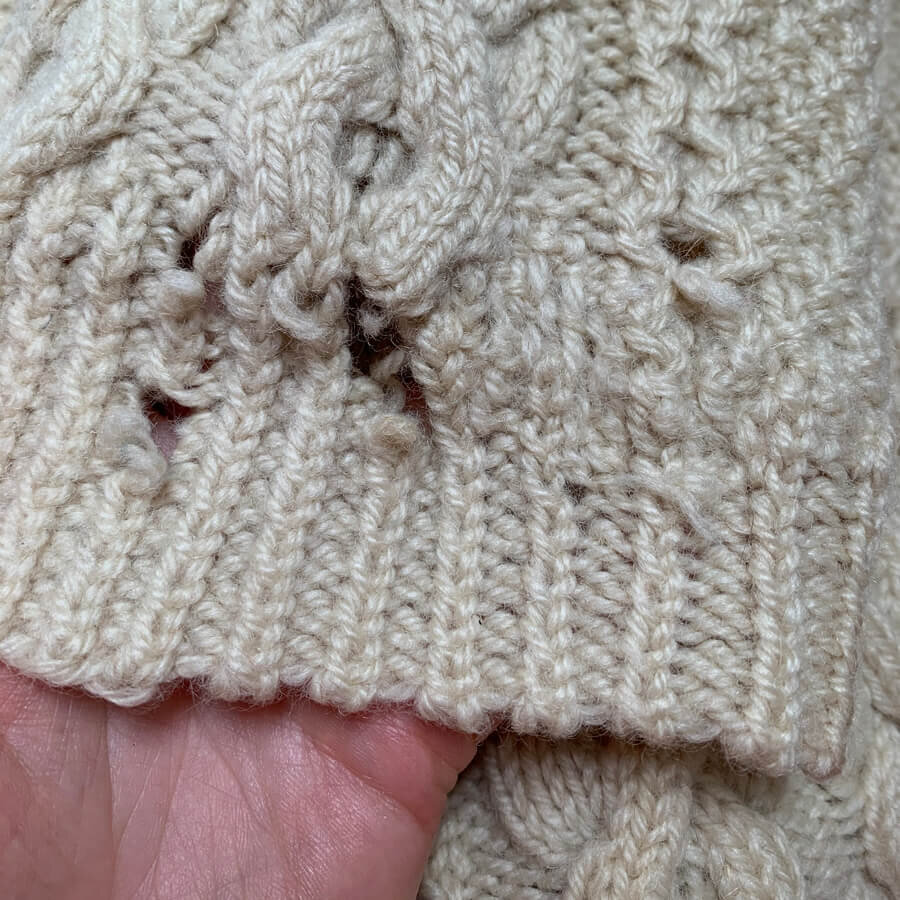Visible Mending : Aran Cardigan
One of my recent mending commissions was a very well loved aran cardigan. It had been shared between two friends: the one who borrowed it 25 years ago still had it, and wanted to repair it as a gift when she finally returned it.
What I particularly loved about it was that it had been previously repaired by two different people before it came to me. The first repairs were in the same yarn, so I suspect they were done by whoever knitted it.
The second repairs were visible and started by my customer, who then decided she would rather pass it on to me. I used her repairs as the starting point for my colour choices.
Knitwear Repair Techniques
This cardigan had quite extensive damage - holes in the cuffs, on the shoulder, on the button bands and two large holes at the front, as well as very worn elbows, and fabric above the cuffs.
Above you can see a before and after photo of one of the cuffs, which I darned in bright colours.
Below you can see both cuffs and you can see the areas of the sleeve I’ve reinforced with Swiss darning.
Darning and Swiss darning are the two best methods for mending knitwear and the ones I tend to use in different creative ways.
Below are three images of the elbows- the first is a before photo, showing the worn fabric and small holes on one elbow. Both elbows had a similar amount of wear. The second image shows my work in progress. The original elbow repair can be seen, and both of them were still lasting well, so I mostly worked around them, and lightly darned into them if I spotted any thinner areas. I’ve use Swiss darning for reinforcement again, as I find it a great way of dealing with worn elbows.
Creative Mending
When it comes to creative visible mending, colour is really important. I normally start every mending project by selecting colours, but this project was slightly different as it had already been started. I left most of the original visible mending in (and undid some areas that weren’t quite working and were warping the fabric) as this was a piece of huge sentimental value, and I thought it important to leave that care and love of a friend in place. This meant that the colour palette had already been partially chosen, so I chose blues and pinks and some yellow that would all work with the colours already there.
The original visible mending (at the bottom left on the front) also set the style of mend. My repairs can often end up being very straight as neat looking, but this project was a bit freer, which this cardigan needed really as it had so many worn areas that needed attention!
It was a wool cardigan, so I used wool to darn it. I also use pure natural fibres so I’m not adding in any synthetics, and the repaired areas will wash the same as the garment. Gradually it will mean they should feel feel the same over time.
Above you can see various photos of the button bands, which were worn in several places. In the worst areas I darned them, and in areas that just needed some reinforcement I used Swiss darning.
The final visibly mended cardigan is colourful, fun, and reminds my slightly of something a painter might wear, with splashes of colour over it. The edges of the hem were a bit worn most of the way round, so I reinforced them too, which I think helped to pull it all together!
I always feel very lucky to be entrusted with much loved knitwear, and this project was one I particularly enjoyed.











